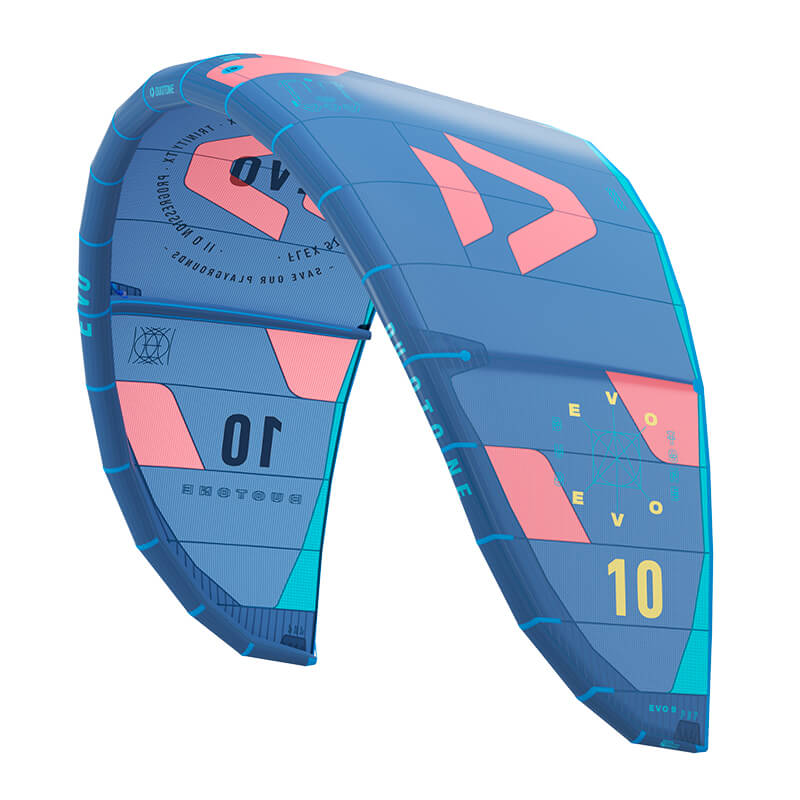When you purchase gear through links on our site, we may earn a small commission. Here’s why you can trust our tests and our affiliate partner.

The world of kiting is constantly evolving and with it, a new generation of riders have been born that demand a kite that can perform to a wide range of conditions. Duotone, a brand synonymous with innovation and quality, have a star-studded team with the likes of 5x World Champ Aaron Hadlow, 2x World Champ Andrea Principi (brah brah brah) and World Champ Liam Whaley – to mention a few – who have all taken the Evo to the top step of podiums in recent years, from the GKA Big Air World Champs to the recent Red Bull Megaloop. Whilst the construction of the kite may vary across the Evo construction range, the DNA of the kite remains the same.
The Evo sets a new benchmark in versatility and performance, with cutting-edge technology developed for the Strong Light Superior (SLS) construction having been added to this edition of the Evo. It feels like a tuned-up high-performance race car, any German automobile manufacturer jump to mind? An overall user-friendly experience is a crucial part of what defines the Evo, allowing limitless progression, from your first day on the water to learning double-loop rotations at the very top of the game. On the water, the Evo felt like the most intuitive kite we had flown this season. Everything felt second nature, from the moment we launched the kite, to how the power is distributed down the bar. This is not a surprise as kite designer Ralf Groesel has produced iteration after iteration since the inaugural Evo in 2008. In Ralf’s own words: “No kite is more perfect for the typical weekend warrior who simply isn’t in the position to spend as much time on the water as a pro.”
Looking at the construction, Ralf has changed the geometry of the kite, creating a more cone-shaped profile which allows for a larger projected area that greatly improves the low end of the Evo. We noticed this during our lighter wind sessions where we demanded more from the kite than normal. It still doesn’t compare to top of the range D/Lab alternatives, but for its price point, you would battle to find a better low-end performance.
You will notice the exclusive Trinity TX canopy, developed in combination with the world leader of polyester fabrics and sail material, Teijin. The Trinity TX canopy promises superior dynamic performance as well as proven superior durability. The Trinity TX is a 3×2 canopy structure compared to the traditional 2×2 or 4×4 canopies. The Evo’s canopy is naturally softer than that of the SLS or D/Lab, allowing the Evo to absorb gusts amazingly well, resulting in a kite that delivers a super smooth experience.
Ralf gave the Evo another upgrade in the single-setting mini bridle that he originally designed for the Dice SLS. This short bridle streamlines the new Evos, eliminating the need for pulleys and enhancing the overall steering performance as well as the sheeting abilities. Notably, we had the complete freedom to fine-tune our riding ability by adjusting the knots on the leading edge. Additionally, the wingtip attachment offers three settings – soft, medium, and hard – enabling customization for diverse riding styles. We used the soft settings during our wave riding sessions where the kite had increased drift capabilities, whilst switching over to the hard setting during our Big Air sessions where we had maximum bar feedback as well as a stiffer overall frame.
We tested the Evo across multiple sessions and felt like we truly gave it a fair all-round freeride experience. The Evo has been designed to be incredibly stable; this was a defining characteristic throughout the test. No matter how wildly we threw ourselves into takeoffs the predictability and consistency of the yank was unreal. We managed to progress from single rotations to single rotations with a board-off in a single session. The Evo didn’t seem too bothered by small mistakes in our piloting – the occasionally late heliloop or flying the kite too far out the window – with its user-friendly design. We found that the 9m Evo on a narrow Click bar with 22m lines was the perfect setup to get the most responsive controlled handling from the kite. The Evo delivered a powerful vertical life that had us wishing we had a WOO. That vertical lift was followed up by a noteworthy hangtime and an impressive ability to catch us time and time again. In short, the Evo’s intuitive handling and versatility across disciplines make it an excellent choice for a broader spectrum of kiters. Whether the goal is high-powered jumps, nimble carving, or even venturing into kite foiling, the Evo proves to be adaptable and accessible.
